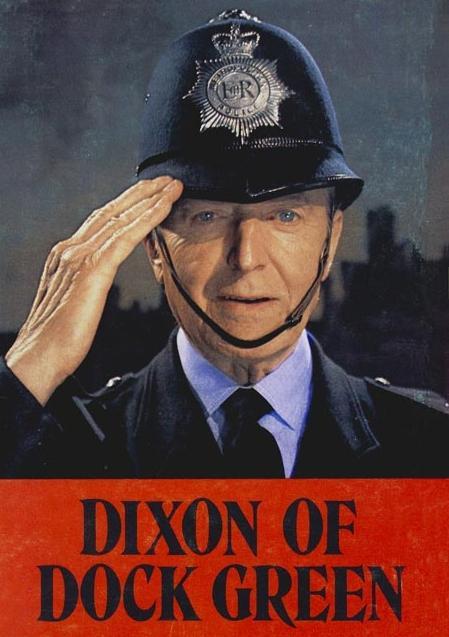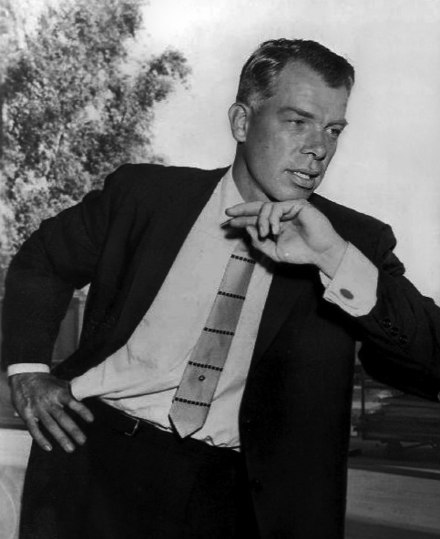
Title: Highway Patrol
Year(s): 1955- 1959
Nationality: American
Protagonist: Police officer
Main character(s): Dan Matthews
Seasons*: 4
Episodes (total)*: 156
Sample episode chosen: “Lie Detector”
Category: Crime
Style: Drama
Format: Solo
Location(s): Unknown American city
Writer(s): Unsure; Frederick Ziv?
Starring: Broderick Crawford
Future stars who had cameos or guest slots: Leonard Nimoy, Clint Eastwood, Robert Conrad, Larry Hagman
First episode: “Prison Break”
Last episode:
Gimmick/Hook (if any): Looks like there were a lot of car/bike chases, plus the episodes were rewrites of actual crime reports.
Spin-offs (if any):
Òf course, I’m not American, but it kind of staggers me when the claim is made that this was, according to our friends Tim Marsh and Earle F. Marsh, “One of the most syndicated shows in television history.” I mean, I never heard of it, and even I have heard of Dragnet and other shows I’ve never seen. Apparently as above, this show used real-life crime reports across the country from which to draw its storylines (basically re-enacting the crimes; not sure you could call them storylines really) and though the state in which the Highway Patrol operated was never confirmed, it’s pretty obviously California. The protagonist, and about the only recurring character bar the narrator, didn’t even have a title, not even Chief. They knew him, perhaps in a tip forward of the hat to The Dukes of Hazzard, simply as boss, and he spent most of his time leaning, it says, on the door of his squad car barking orders and instructions into a bullhorn, many of which would include the code “ten-four!” something perhaps not that well known to the general TV audiences at that time, at least until the rise of CB radio, and also possibly the reason why the show was retitled Ten-Four in later reruns.
As you can see above, quite a few claims to later fame, including Leonard Nimoy and Clint Eastwood, and a further Star Trek link is that a struggling writer of westerns who would later be immortalised as the creator of that show wrote five episodes for this one. Whether Roddenberry and Nimoy ever met I don’t know, but I’d say it’s doubtful; in those days, writers wrote and sent in their scripts. They would hardly ever be present on the set. In terms of, to use a later popular phrase, keeping it real, Highway Patrol had two consultants on the staff, one a serving officer with the CHP (California Highway Patrol, as if you didn’t know) and one a retired one, to make sure all the technical details were correct. I guess you have to admire that kind of attention to detail in a show that seems to have been mostly about, as above, car chases, but there are episodes to watch, so I’ll confirm that shortly.
Highway Patrol seems to have had its dark side too. Broderick got so worn out with the filming schedule (two shows a week, would you believe?) that he turned to drinking and quit the show, snarling “We ran out of crimes” when asked for a reason for his departure and the end of the series. In America? Surely not. However this is where it turns dark. The creator, one Artie Ziff sorry Frederick Ziv forced Crawford to sign for one of his new shows, holding back his cut of Highway Patrol until he did so. That’s some Hollywood hardball right there! Perhaps fittingly, the new show was axed after one season. What happened to Broderick Crawford? Sure let’s check it out. Looks like he lasted another thirty years. But it always does to follow interesting links, and in an article about the man we find the lie, or partial truth, in the Wiki story: the hectic schedule didn’t drive (sorry) him to drink, it perhaps exacerbated his already heavy problem with alcohol, which had resulted in him getting so many DUIs that he was in fact banned from driving, so despite his role as basically a police chief, he couldn’t drive the car in the show, only for very short scenes, and someone else would have to take over if longer journeys were required.
In fact, it emerges that Crawford was so hard to deal with that Ziv was the only one willing to give him a job, and that Highway Patrol, despite its tough schedule, revitalised his career, which had hit a slump. Well, so it says, but the evidence isn’t there for me; in fact, he had starring roles in movies both before and just after the series, so I don’t know. It appears that in addition to being a hard drinker he was one of those Americans who eats three hamburgers for breakfast or something - ate a lot anyway - and put on a lot of weight, all of which no doubt contributed to the multiple strokes that ended his life in 1986.
So what’s it like? Well, the usual stentorian voiceover about who the “Highway Patrol” are (without naming any state) and then it’s pretty clear this isn’t going to be light-hearted, as a thief (looking rather like someone who has strayed off the path to a western movie, with his long kerchief mask) pistol-whips an old lady. I mean, it’s the 1950s, so you don’t see it, but he raises the gun and she goes down, and it’s pretty obvious what has happened. I must say, I find it rather amazing that the narrator tells us that she managed to identify the man. His face was almost completely covered, and she must be dazed from the attack. Maybe she recognised his voice? Oh no, I see: she recognised his hat and coat; he was a guest in the motel. Still a bit thin. What was so special about the hat and coat?
Good to see that they’re not sensationalising the lie detector here as some shows did back then, as if it was some all-seeing oracle that could determine a man’s guilt or innocence. Matthews tells him that the results are not admissible in court, which even back then they were not, and still are not. It’s a useful tool, but it won’t do a cop’s job for him. The nephew, when they return to the motel to re-question the old lady, is very adversarial and defensive, almost throwing an alibi at them before they’ve even asked for one. Very suspicious. You’d have to wonder, though, why they’re relying solely on her identification of the guy. If he had a gun, have they not dusted it for fingerprints? Where is the gun? Do they have it? I know DNA was not even discovered at this time, but fingerprinting was part of normal police SOP. Even when a witness comes forward with a book of matches the alleged attacker - or someone dressed like him anyway - gave him, nobody thinks to dust it to see whose fingerprints are on it?
Okay so the “witness” and the nephew are, to use the language of the time, in cahoots together. No wonder he stepped forward. It’s not that often people go out of their way to involve themselves with the police. I wonder why there’s the constant sound of an aircraft in the outdoors scenes? It’s not as if they’re doing any aerial shots. Maybe they’re filming near an aerodrome? Hey! Why has Mister Witness got the mask on? He’s coming at the aunt from behind (ooer!) and he clubs her before she even knows he’s there. Then he removes the mask. Who was it for? Idiot. That’s one tough old lady though! Pistol-whipped twice at her age and she’s still alive!
Meh, from what I read I expected something more exciting. No real car chases - hardly see cars at all - and no shots of Crawford barking into anything or leaning on anything. In fact, if anything I found him very laid-back. Maybe I just picked a bad episode, but that seemed a little cerebral and boring to me, making me surprised it was such a popular show. Definitely seen better.









